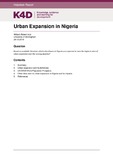| dc.contributor.author | Avis, William Robert | |
| dc.coverage.spatial | Nigeria | en |
| dc.date.accessioned | 2019-11-28T15:42:43Z | |
| dc.date.available | 2019-11-28T15:42:43Z | |
| dc.date.issued | 2019-10-29 | |
| dc.identifier.citation | Avis, W. (2019). Urban Expansion in Nigeria. K4D Helpdesk Report 692. Brighton, UK: Institute of Development Studies. | en |
| dc.identifier.uri | https://opendocs.ids.ac.uk/opendocs/handle/20.500.12413/14797 | |
| dc.description.abstract | This rapid literature review, surveys the available literature on urban expansion in Nigerian cities/towns over the coming decades. It presents information on population growth, geographic expansion and urban density to illustrate that urban centres in Nigeria are expanding at different rates which are dependent on the aspect of urbanisation considered. Rapid urbanisation is a global trend exerting an increasing impact on society. It is broadly accepted that for the first time, the majority of the world’s population lives in what can loosely be classified as ‘urban areas’. In 2014, an estimated 55% (around 3.8 billion people) lived in towns or cities (UNDESA, 2019: 1). The 2018 Revision of World Urbanization Prospects estimates that this proportion is expected to increase to 68% by 2050. Furthermore, future increases in the size of the world’s urban population are expected to be highly concentrated in just a few countries. Together, India, China and Nigeria will account for 35% of the projected growth of the world’s urban population between 2018 and 2050. By 2050, it is projected that India will have added 416 million urban dwellers, China 255 million and Nigeria 189 million. The identification of urban centres in Nigeria is based on population and legal or administrative criteria. As noted above, Nigeria adopts a threshold population of 20,000 people as a criterion for defining an urban centre. In addition to this, all states and local government area headquarters have historically, legally or administratively been regarded as urban centres (National Urban Development Policy, 2006). At the national scale, the most extensive urban spatial expansion has been concentrated around four urban fields (Bloch et al., 2015): A Northern conurbation centred around Kano, which has a north-south axis running from Katsina to Zaria and an east-west axis running roughly from Funtua to Hadejia; An emergent Central conurbation running from Abuja in the southwest to Jos in the north-east; A South-Western conurbation stretching from Lagos in the south to Ilorin in the north to Akure in the east; A South-Eastern conurbation within a roughly square zone encompassing Benin City, Port Harcourt, Calabar and Enugu. | en |
| dc.language.iso | en | en |
| dc.publisher | IDS | en |
| dc.relation.ispartofseries | K4D Helpdesk Report;692 | |
| dc.rights.uri | https://www.nationalarchives.gov.uk/doc/open-government-licence/version/3/ | en |
| dc.subject | Governance | en |
| dc.subject | Population | en |
| dc.title | Urban Expansion in Nigeria | en |
| dc.type | Helpdesk | en |
| dc.rights.holder | © DFID - Crown copyright 2019 | en |
| dcterms.dateAccepted | 2019-10-29 | |
| rioxxterms.funder | Department for International Development, UK Government | en |
| rioxxterms.identifier.project | K4D | en |
| rioxxterms.version | VoR | en |
| rioxxterms.funder.project | 238a9fa4-fe4a-4380-996b-995f33607ba0 | en |

